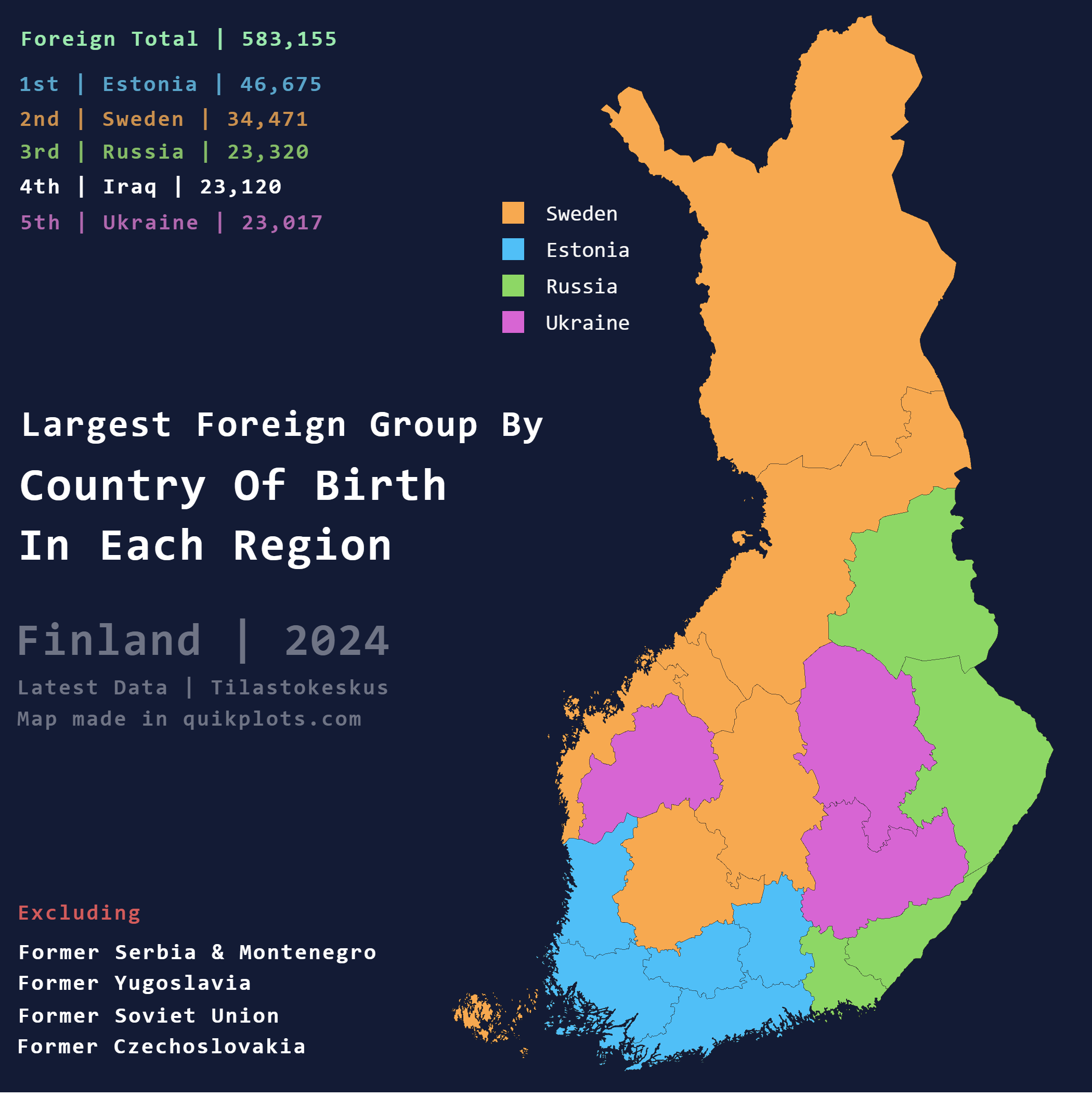Largest Foreign Group by Region Map of Finland


Marcus Rodriguez
Historical Geography Expert
Marcus Rodriguez specializes in historical cartography and geographic data analysis. With a background in both history and geography, he brings unique...
Geographic Analysis
What This Map Shows
This map illustrates the largest foreign-born group residing in each region of Finland as of 2024. Utilizing data from the Official Government Statistics of Finland, the visualization highlights the demographic diversity across various Finnish regions. By examining the largest foreign population in each area, we can glean insights into cultural influences, migration trends, and the socio-economic fabric of Finland.
Deep Dive into Finland's Demographics
Finland is known for its unique cultural landscape, which is continuously shaped by immigration patterns. Over the years, various waves of migration have introduced new communities into the Finnish society, each contributing to the nation's rich cultural tapestry. According to the 2024 data, the foreign population in Finland has been steadily growing, reflecting both the global movement of people and the increasing recognition of Finland as a desirable place to live.
The largest foreign groups often consist of individuals from neighboring countries, particularly from the European Union, as well as asylum seekers and labor migrants from regions beyond Europe. For example, in the Uusimaa region, which includes the capital city of Helsinki, the largest foreign group is from Estonia. This is not surprising, considering the geographical proximity and historical ties between the two nations. What's fascinating is that the ease of movement within the EU has facilitated a significant Estonian presence in Finland, especially in urban areas where job opportunities abound.
In contrast, in regions such as North Karelia, the largest foreign group may be from a more distant country, showcasing the varied nature of migration across Finland. The demographics of these groups can be influenced by several factors, such as employment opportunities, family reunification policies, and the presence of established communities.
Understanding these demographics is crucial for policymakers and local governments as they navigate the complexities of integration, resource allocation, and community services. Moreover, it allows us to appreciate the multicultural dynamics that are increasingly becoming a part of everyday life in Finland.
Regional Analysis
Let's break down the regions based on the data from the map: - **Uusimaa**: As mentioned, Estonia leads as the largest foreign group, indicative of the close economic and social ties between the two countries. The diverse metropolitan environment of Helsinki offers numerous opportunities for Estonian migrants, from jobs to education. - **Pirkanmaa**: This region, known for its vibrant city of Tampere, has a significant population from Sweden. The historical connections and shared language contribute to this demographic trend. Interestingly, the Swedish-speaking Finns often have familial ties that span generations, bridging the cultural divide. - **Lapland**: While it may seem remote, Lapland has seen a rising number of foreign workers, particularly from countries like Thailand, drawn to its unique lifestyle and seasonal job opportunities in tourism. This influx presents both challenges and opportunities for cultural exchange in the region. - **Åland Islands**: This autonomous region has a notable Swedish-speaking population, emphasizing the importance of linguistic ties in migration patterns. The islands have a unique status that attracts Swedish residents seeking a quieter lifestyle yet still wanting to maintain their cultural connections.
These variations showcase how geography, history, and socio-economic factors intertwine to shape the foreign population in Finland's regions. Each group brings its own customs, traditions, and contributions to society, enriching the Finnish identity.
Significance and Impact
Understanding the largest foreign groups in each region of Finland is not just about numbers; it's about the implications these demographics have on Finnish society as a whole. As Finland continues to evolve as a multicultural society, the integration of these diverse groups into the fabric of everyday life becomes increasingly important.
In recent years, Finland has seen a growing emphasis on multicultural education and policies aimed at fostering inclusivity. The presence of foreign populations can impact everything from local economies to cultural events, helping to shape a more dynamic and diverse society. However, this also raises questions about resource distribution, community support, and social cohesion.
Looking ahead, trends indicate that immigration will continue to play a significant role in shaping Finland's demographics. As global challenges such as climate change and conflict drive people to seek new homes, Finland's approach to welcoming and integrating these communities will be crucial for its future.
In conclusion, the map of the largest foreign group in each region of Finland is more than a snapshot of demographics; it’s a reflection of the country’s ongoing journey towards becoming a more inclusive and multicultural society. As we observe these trends, it's essential to consider how they will influence Finland's identity in the years to come.
Visualization Details
- Published
- October 5, 2025
- Views
- 38
Comments
Loading comments...